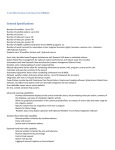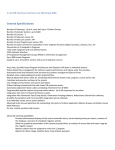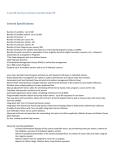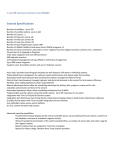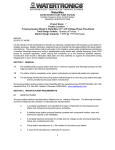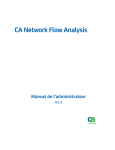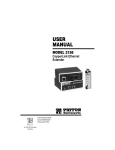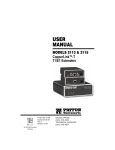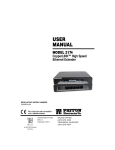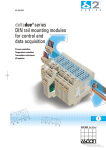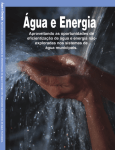Download Toro Lynx Central Control SE 2.0 GDC Specifications
Transcript
LYNX SE CENTRAL CONTROL FOR NETWORK GDC General Specifications Number of Gateways: Up to 4, each with up to 2 Station Groups Number of decoder stations: up to 500 Number of Courses: 1 Number of holes per course: 48 Number of holes per system: 48 Number of Area Programs per system: 99 Number of switch controls for automation of non-irrigation functions (lights, fountains, aerators, etc.): 50 100 Hydraulic branches Supports up to 10 weather stations and 1 hydraulic source Area, Hole, Sprinkler based Program Architecture with Dynamic Drill down to individual stations. Station Based Flow management for optimum system performance and reduce water time window Automated multi-level hydraulic flow and electrical systems management (Electro-Flow) Detailed, color-coded graphing of system projected flow Manual adjustment factors allow for scheduling refinement by station, hole, program or course Calculates and executes runtimes to the minute Low voltage communication over power operations Utilizes latching solenoid with Fail-safe Power Off protection mode Automated adjustment factors allow scheduling refinement from 0-900% Optional weather station and pump station alarms: Up to 99 responses for any alarm Integration with Toro Turf Guard Soil Sensor system. Pump Station monitoring with Flowtronex Pace Pump Station, Flowtronex Pumplog software, Watertronics WaterVision software, Grundfos Pump Station with Toro-Grundfos Integration Service software. User-definable names versus system defaults On-line, context-sensitive Help screens Advanced reporting capabilities: Provides informational displays of the central controller status, actual watering times per station, contents of the database, overview of scheduled irrigation activity Allows for graphical presentation of the system projected flow, an analysis of sensor data and water usage by the irrigation system Reports for Water Usage Weather data, Pump Station operation with Optional Weather ET and Pump Integration software Hand-held radio capability Remote sprinkler activation by area and hole address Remote sprinkler activation by hardware address Runtime Adjustment by percentage Pause and resume Station Test by area and hardware Station activation by decoder serial number Irrigation methods: Basic: daily run times or application amounts assigned to programs With Weather ET software option: Intermediate: run times modified automatically with changes in daily ET, identified by ET source Advanced: run times calculated automatically based on sprinkler data, site parameters and measured ET Microsoft Windows 7 Ultimate operating platform True 100% 64-bit architecture Supports 16 languages: English, Bulgarian, Simplified Chinese, Czech, Danish, Dutch, French, German, Italian, Japanese, Korean, Norwegian, Portuguese, Russian, Spanish and Swedish Supports U.S and metric units of measure Runs on Toro basic computer (contact local distributor for current specifications) Integrated Map software allows: Dynamic, interactive operation Use of a non-scaled graphic image file Use of a scaled CAD generated map Enhanced graphics GPS compatibility for accuracy End User Editing of Sprinkler, Sensor, and Switch locations Floating of map onto secondary 1080P monitor Standard Weather Software allows: On-site or off-site weather station Rain Shut Down alarm response Optional Weather ET software allows: Automatic system adjustment using ET Interactive, automatic response to the central User-defined alarm thresholds Rain Re-Flow alarm responses Standard Pump software allows: Monitoring of 1 pump station Optional Pump Integration software allows: Pump station integration with 1 pump station and alarm responses Bidding Specifications Central Controller The central controller shall utilize a personal-computer-based, Microsoft Windows 7 Ultimate platform, userfriendly irrigation management and control program. The central controller shall utilize a client/server architecture. Computer shall include 2 video outputs and allow map graphic to be floated onto secondary monitor. The central controller shall utilize site graphics with 64-bit software, including site graphics at the station level. The software shall be presented in a “flat” display, where all of the information needed is available to the user for a given operation, without having to open and close additional windows. The central controller shall have programs based on a hierarchy organized the same as the golf course. Course, Areas (greens, tees, fairways, etc.) followed by holes (1 through 48), followed by the individual sprinklers. The central controller shall have the ability to view the system at any of the four levels (course, area, hole, sprinkler) by Dynamic Drill down (simply clicking on a plus/minus box ) to give the user intuitive control. A graphic red “Water Drop” will identify areas and holes that have stations turned off. A graphic green “Water Drop” will identify areas, holes and stations set to run automatically. A graphic blue “Water Drop” will identify areas not scheduled to water. The central controller shall allow the user to schedule areas to irrigate by either entering runtimes in minutes, or by entering amount of water to apply. If the amount is utilized, the corresponding minutes will automatically be calculated and displayed. If minutes are utilized, the corresponding amount of application shall be calculated and displayed. Runtimes shall be calculated and executed to the minute. The central controller shall have a “Course Report” to allow the user to determine the status of each sprinkler station on the golf course. The Course Report shall auto generate after each night’s watering to allow confirmation of all sprinkler runtimes at a glance. The Course Report will display all Automatic, Manual, and currently running stations. Stations that have not operated as scheduled shall be identified with a graphic red “Water Drop”. The Course Report / Alert Panel shall display feedback from the Gateway(s) to indicate station status. The Course Report will utilize the Area, Hole, Station layout with Dynamic Drill down to quickly navigate to exceptions. The central controller shall support the creation of a customized site map displaying multiple layers. The central controller shall allow the user to quickly create a map from any digital image (jpeg, bmp or tif format). The control system will allow the user to edit the locations of sprinklers, Turf Guard Sensors, and switches on the map. The central controller shall provide system status at the station level and display changes in status. The central controller shall be capable of creating user-defined work orders. If a scaled CAD map is utilized, the central controller will display area and distance measurements. The central controller shall be capable of graphically displaying projected flow on the map at the station level and displaying station activation utilizing a color-coding system that shows how stations will activate during the next 24 hours. The central controller shall be capable of creating irrigation programs through the map and making station level percentage adjustments. When programming or manually running stations, the map shall be capable of automatically zooming into the stations, holes, and areas selected. The central controller shall have the ability to communicate with and control 4 GDC Gateways, each with up to 2 Station Groups (Wire Paths) for a total of up to 500 stations. The central controller shall automatically calculate sunrise and sunset based on longitude, latitude and date, and provide this information for starting or stopping a program in relation to sunrise or sunset. The central controller shall permit true random access of all stations in the system and allow area programs to be constructed with any combination of stations regardless of wiring sequences or satellite designation. The central controller shall have the ability to manually adjust (percentage increase/decrease) by course, area, hole or station. With Optional Weather ET software module, system adjustment factors may be input via actual percentage or operational ET. The central controller shall have the ability to connect to a weather station. The weather station will measure and store temperature, relative humidity, dew point, wind speed and direction, and solar radiation for use in the calculation of evapo-transpiration. The central shall have the ability to automatically calculate and adjust watering times based on evapo-transpiration. The central controller shall also have the ability to reduce the automatically calculated runtime by the rainfall measured over the preceding 24 hours. Further, the central controller shall have the ability to adjust calculated runtimes after they have been scheduled utilizing a Rain Re-Flow alarm response. The central controller shall include the Turf Guard Soil Sensor software. Individual sensor data can be assigned to specific sprinklers to allow the user to view current soil moisture on the Watering Plan, allowing the user to choose to skip watering if moisture levels are above user-defined thresholds, or to activate stations if moisture levels are below defined thresholds. The central controller shall employ advanced hydraulic/electrical systems management, allowing the user to specify hydraulic system design (source and pipes representing mainlines, branches and flow groups) and the hydraulic limits of each entity. The central controller shall manage system flow by automatically generating the appropriate station start times based on the hydraulic limits set for each source and pipe, and for the simultaneous station limit set for each wire path. The central controller shall display projected flow by source, course, area, program and hole using colors to differentiate. The graph will calculate and display the maximum instantaneous flow as well as the total volume. Maximum flow and volume will be displayed in user-selected units. When the Optional Pump integration software is configured, the actual flow reported by the pump station can be displayed simultaneously with the projected flow for up to the last 7 days. The central controller shall have the ability to manually start programs for an entire area or for an individual hole/area. Manual programs may be started in normal program time or a manually selected time. The central controller shall have the ability to start a multi-manual cycle on a wire path, running up to 100 stations simultaneously with a run time of up to 99 minutes. The central controller shall have the ability to independently suspend (hold) the automatic operation of an individual station or course. The station hold duration shall be programmable for the current irrigation day up to 30 days, or may be permanent. The central controller shall have the ability to control non-irrigation devices through switch outputs. Each switch (up to 50) will have an independent seven-day calendar schedule and start times for up to 24 starts. Switch outputs may run from one minute to 23 hours and 59 minutes (programmable in one-minute increments), with individual start times for each station (switch output). Switches may also be scheduled to run with any program and include the ability to offset the start time prior to or after the start of the program. The central controller shall allow a user-defined response to a Gate Way alarm for pump pressure or rainfall and allow a user-defined response to a weather station rainfall threshold. The central controller shall offer a Weather ET software option for configuring weather alarms for Rainfall Rain Re-Flow alarm response, Wind Speed, Temperature, Wind Direction, Solar Radiation, Relative Humidity, Dewpoint. The central control shall offer a Pump Integration software option shall support up to 99 alarm responses. The central controller shall provide system status information on communication with the Gate Way(s) and wire paths automatically and continuously without requiring alarm configuration. The central controller shall provide reports detailing the following information: 1) projected schedule activity, 2) contents of the database constructed while programming the central controller, 3) overview of scheduled irrigation activity including start time, end time and area information, flow and program, 4) report stations that did not acknowledge a message to run. The central controller shall be capable of monitoring 1 pump stations manufactured either Flowtronex, Watertronics or Grundfos. The central controller shall be capable of displaying flow and pressure. With the Optional Pump Integration software, the central controller shall be capable of responding to “alarm” conditions based on data received from the Flowtronex, Grundfos or Watertronics pump station. When alarms are activated, the irrigation system will respond in one of the following ways: log only no response, pause irrigation, resume irrigation, turn a switch on/off, cancel a program or station, initiate a rain hold or cancel, start a program or initiate a ReFlow response. The central controller shall have “Power Guard”, the ability to limit electrical consumption during specified times when integrated with a Flowtronex Pump station equipped with their Pace controls. The system shall require a personal computer which has been certified by the manufacturer for use with the central control system. The system shall come with a one-year dedicated support program provided by the manufacturer which includes extended warranties, 24-hour component replacement, toll-free help-line support and remote diagnostics by a licensed irrigator. The system shall include NSN Connect for secure remote access to allow the user to operate the Lynx system from any computer connected to the internet. This will also allow NSN to do remote diagnostics and support of the central controller. The system shall include one year of NSN Connect Plus, a service that will allow NSN to remotely monitor the computer 24/7/365 and will alert the user to internal computer hardware and software issues. The system shall include one year of Lynx Mobile, a service which will allow the user to remotely control Lynx 24/7/365 from any web enabled mobile device. This service will provide for manual irrigation, communication diagnostics, viewing of course status and alerts The central controller shall be developed, manufactured, qualified and released in the USA by an ISO 9001certified facility. The central controller, model number ____________, shall be manufactured by The Toro Company, Irrigation Division, Riverside, California, USA. Note: Lynx, Electro-Flow, NSN, NSN Connect and NSN Connect Plus are trademarks of The Toro Company. Microsoft and Windows are registered trademarks of Microsoft, Inc.





